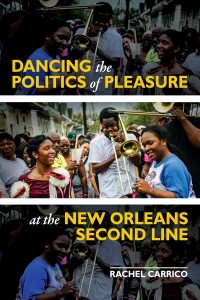Dance Studies professor and author Rachel Carrico moved to New Orleans, like so many young creatives, in the years after Hurricane Katrina and the failure of the federal levees that flooded 80 percent of the city. She made many connections and immersed herself in the Black culture of the city. She eventually even joined the Ice Divas, a social and pleasure club, after attending numerous second line parades and is one of the few White people currently parading as a member of one of the city’s many clubs.
Now, 10 years later, she has released a fascinating book, which explores the many aspects of the second line culture of New Orleans through an interesting lens—the role of dance. The book is divided into six chapters, with brief interviews with culture bearers separating each section, including “Coming Out the Door,” “community,” “Spirit,” “Freedom,” “Do Whatcha Wanna” and “Home.”
While five of the six are self-explanatory, “Coming Out the Door” refers to moment at the beginning of every second line when each of the members have an individual moment in the spotlight to demonstrate their dancing prowess and show off.
The book includes numerous quotations, references and footnotes galore, which is expected from an academic book, but it remains entirely readable for the general public, with the notes providing additional insight in addition to citations. The best parts are when Carrico describes the dancing, using professional terms and also creative language, to explain what is mostly undefinable and must be experienced to be fully understood. As a long time second liner and observer of the culture, she even surprised me several times with her insight.
Carrico doesn’t shy away from the political part of the title, explaining in no uncertain terms the precarious nature of Black life in the face of mainstream capitalism and gentrification and how second lining and the pleasure associated with it are facets of Black resistance. One section of particular interest (full disclosure—I was interviewed for Carrico’s book)—centers on the Glass House—a sorely missed, iconic club in Central City that played a major role in the brass band revival.
Carrico has written a book that adds a major chapter to the history of Black culture in New Orleans. It is a continuation of numerous other efforts over the years and brings the story fully into the 21st century.




